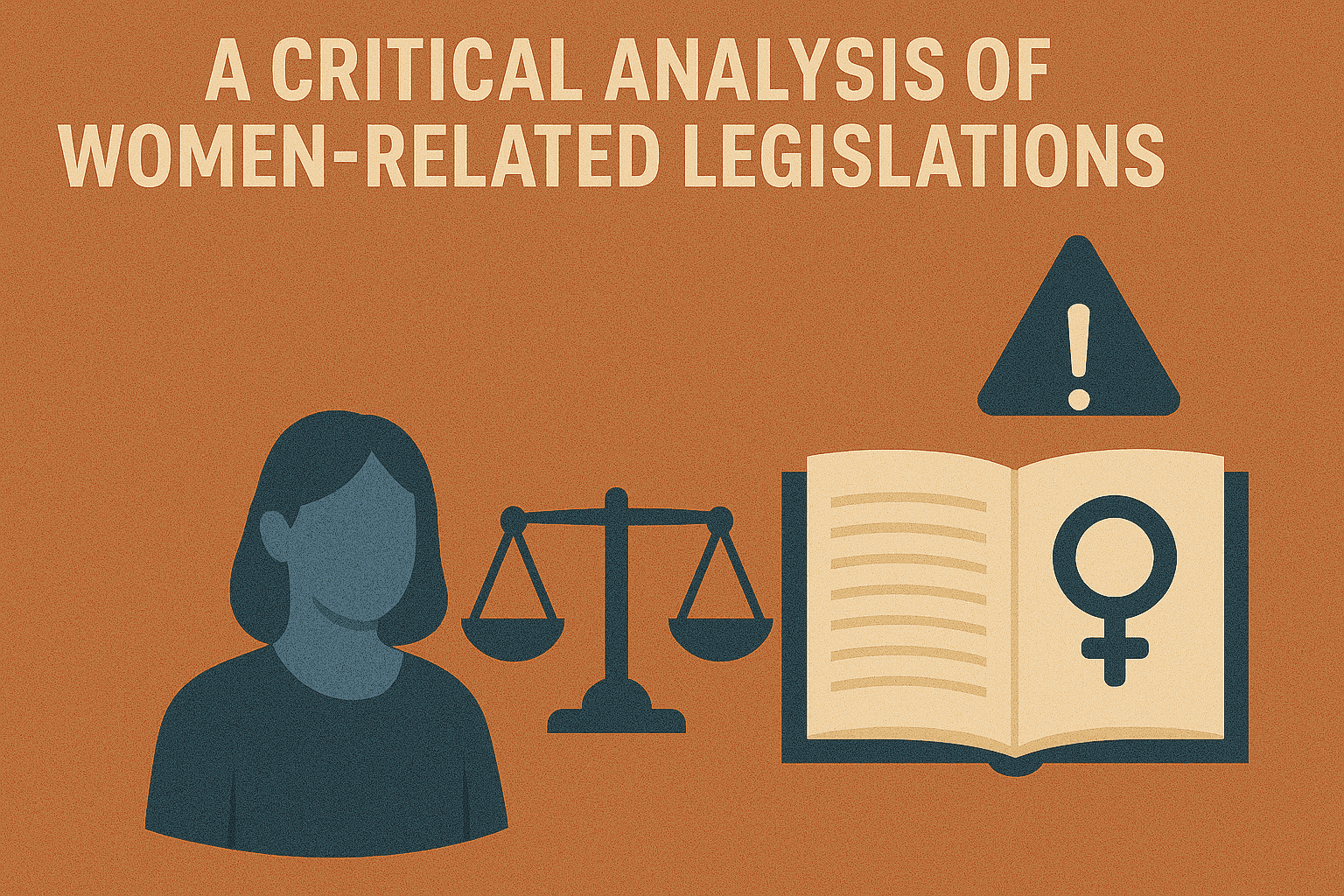India Has Demonstrated Its Dedication To International Agreements And Constitutional Mandates By Passing Important Laws Pertaining To Women That Advance Gender Equality And Safeguard Women’s Rights. Systemic Problems Like Domestic Violence, Workplace Harassment, And Crimes Related To Dowries Have Been Addressed By Landmark Laws Like The Protection Of Women From Domestic Violence Act (2005), The Sexual Harassment Of Women At Workplace (Prevention, Prohibition, And Redressal) Act (2013), And Amendments To The Dowry Prohibition Act (1961). By Granting Legal Remedies, Raising Awareness, And Establishing Institutional Channels For The Administration Of Justice, These Laws Have Empowered Women. But Problems Still Exist, Such As Poor Execution, Social Opposition, And Enforcement Gaps Brought On By A Lack Of Funding And Cultural Prejudices. Access To Justice Is Frequently Restricted For Rural Women And Vulnerable Populations, And New Legal Frameworks Are Required In Response To Rising Challenges Like Reproductive Rights And Cybercrimes. This Critical Analysis Assesses How Well These Laws Have Advanced Women’s Rights, Identifies Major Implementation Roadblocks, And Emphasizes The Necessity Of Strict Oversight, Gender-Sensitive Law Enforcement, And Public Awareness Initiatives. To Guarantee That These Laws Result In Real Empowerment And Equality For Women Throughout India, It Will Be Crucial To Advance Institutional Capabilities, Make Use Of Technology, And Promote Changes In Public Attitudes.
Keywords: – Women’s Rights, Gender Equality, Indian Legislation, Empowerment, Implementation Challenges
Introduction
India’s Legal Framework For Women’s Rights Has Changed Dramatically Over Time, Reflecting Both Its Adherence To International Agreements Like Cedaw And Its Constitutional Commitment To Gender Equality Under Articles 14, 15, And 21. To Address Widespread Problems Like Domestic Abuse, Workplace Harassment, And Discriminatory Practices, Laws Like The Protection Of Women From Domestic Violence Act (2005), The Sexual Harassment Of Women At Workplace Act (2013), And The Muslim Women (Protection Of Rights On Marriage) Act (2019) Have Been Passed Over The Course Of Several Decades. By Offering Legal Safeguards, Institutional Assistance, And Channels For Redress, These Laws Seek To Empower Women And Represent Significant Advancements In The Fight Against Patriarchal Practices. However, Systemic Issues Like Uneven Enforcement, Social Opposition, And Poor Infrastructure, Especially In Rural Regions, Limit The Effectiveness Of These Laws.
The Obstacles Marginalized Women Encounter Are Exacerbated By Societal Shame, Poverty, And Illiteracy. New Problems Like Cybercrimes And Changing Reproductive Rights Highlight Legal Framework Flaws Even More. In Order To Guarantee That These Laws Result In Significant Empowerment For Women Across India’s Varied Socioeconomic Landscape, This Critical Analysis Looks At The Successes Of Women-Related Laws In Promoting Gender Justice, Assesses The Structural And Cultural Barriers To Their Implementation, And Suggests A Path Forward Through Improved Institutional Mechanisms, Technology-Driven Solutions, And Societal Sensitization.
Historical Context and Legislative Evolution
In The Past, Patriarchal Customs In India Have Led To Systematic Discrimination Against Women, With Customs Like Dowries, Purdah, And Sati Eroding Their Standing. The Foundation For Change Was Established During The British Colonial Era By The Introduction Of Laws Like The Hindu Widows’ Remarriage Act Of 1856 And The Bengal Sati Regulation Of 1829. The Indian Constitution, Which Forbade Sex-Based Discrimination And Gave The State The Authority To Implement Affirmative Action Policies For Women, Laid The Groundwork For Gender Equality After Independence. Key Legislations Followed, Addressing Specific Issues:
• The 1961 Dowry Prohibition Act Made It Illegal To Give Or Accept Dowries In An Effort To End The Custom.
• The Equal Remuneration Act Of 1976 Addressed Economic Inequality By Requiring Equal Compensation For Equal Effort.
• The Protection Of Women From Domestic Violence Act Of 2005 Gave Women Who Were Abused At Home Legal Options.
In Accordance With The Vishaka Guidelines, The Sexual Harassment Of Women At Workplace (Prevention, Prohibition And Redressal) Act Of 2013 Established Procedures To Deal With Workplace Harassment.
• Women’s Reservation Act, 2023: This Important Step Toward Political Empowerment Requires 33% Reservation For Women In State Assemblies And The Lok Sabha.
These Laws Demonstrate India’s Adherence To Global Agreements Such As The Beijing Declaration And The Convention On The Elimination Of All Forms Of Discrimination Against Women (Cedaw).
ACHIEVEMENTS OF WOMEN-RELATED LEGISLATIONS
Empowerment of the Economy
By Guaranteeing That Women Receive Equal Compensation For Equivalent Work, The Equal Remuneration Act Of 1976 And Its Successor, The Code On Wages Of 2019, Have Reduced Salary Discrepancies In Formal Industries. By Offering Paid Maternity Leave, The Maternity Benefit Act Of 1961 Encouraged Women To Enter The Workforce. In 2017, Modifications Were Made To Increase Benefits To 26 Weeks. Since 2017, More Than 1.75 Crore Women Have Benefited From Financial Assistance For Pregnant And Lactating Women Through Programs Like The Pradhan Mantri Matru Vandana Yojana.
Social and Legal Protections
The Protection Of Women From Domestic Violence Act And The Dowry Prohibition Act Have Established Legal Safeguards Against Domestic Violence And Harassment Associated With Dowries. For Women Impacted By Violence, The Opening Of More Than 700 One Stop Centers Throughout India Has Provided Integrated Help. By Requiring Internal Complaints Committees In Businesses, The Sexual Harassment Of Women At Workplace Act Has Promoted Safer Workplaces.
Political Representation
Women’s Participation In Local Governance Was Greatly Increased By The 73rd And 74th Constitutional Amendments (1993), Which Set Aside One-Third Of Seats For Women In Urban Local Bodies And Panchayati Raj Institutions (Pris). With 1,375,914 Female Delegates As Of 2022, Women Made Up 44% Of Pri Representatives. Women’s Representation At Higher Legislative Levels Is Expected To Be Significantly Improved Under The Women’s Reservation Act Of 2023.
Education and Health
With The Gender Parity Index Increasing From 0.92 In 2014–15 To 1.04 In 2018–19, Legislative And Policy Initiatives Such As The Beti Bachao Beti Padhao Program Have Improved The Sex Ratio At Birth In 422 Out Of 640 Districts And Increased The Number Of Females Enrolled In Secondary Education.
Challenges in Implementation
In India, Laws Pertaining To Women Are Hampered By Cultural Biases, Community Opposition, And Inconsistent Enforcement. Access Restrictions Are Made Worse By A Lack Of Funding, Insufficient Training For Law Enforcement And The Judiciary, And Low Awareness, Particularly In Rural Areas. Poverty And Illiteracy Exacerbate The Problems Faced By Marginalized Women, While New Cybercrimes Highlight Legal Loopholes.
Weak Enforcement Mechanisms
Due To A Lack Of Funding, A Shortage Of Qualified Staff, And Court Delays, Many Laws Are Not Adequately Enforced. For Example, In Rural Communities Where Dowries Are Still A Cultural Norm, It Has Been Challenging To Enforce The Dowry Prohibition Act. Enforcement Deficiencies Are Highlighted By High Rates Of Violence, Such As The 6,589 Dowry Killings And The 136,243 Cruelty Charges In 2021.
Societal and Cultural Norms
Patriarchal Attitudes Continue To Undermine Legislative Intent. Practices Like Sex-Selective Abortions And Forced Marriages Persist, Contributing To A Skewed Sex Ratio And Gender-Based Violence. The Global Gender Gap Report 2024 Ranked India 129th, Reflecting Challenges in Educational Attainment And Political Empowerment.
Lack of Awareness
Many Women Are Not Aware Of Their Legal Rights, Especially In Rural Areas. Just 13% Of Indian Girls Are Aware Of Menstruation Prior To Menarche, According To A 2011 Unicef Research, Highlighting Larger Disparities In Knowledge And Education. This Restricts Their Capacity To Exercise Their Rights Or Obtain Legal Protections.
Economic and Structural Barriers
In 2021, Only 23% Of Women Were Employed, Compared To 72.7% Of Men, Indicating That Women’s Economic Engagement Is Still Low. Economic Empowerment Is Nevertheless Constrained By Structural Obstacles, Such As The Hindu Succession Act Of 1956’s (Before Its 2005 Revision) Lack Of Access To Property Rights.
Political Underrepresentation
India Ranks 143rd In The World For Parliamentary Representation, With Women Holding Just 13.6% Of Seats In The Lok Sabha And 13% In The Rajya Sabha As Of 2024, Despite Advancements At The Municipal Level. Progress Is Further Hampered By The Women’s Reservation Act’s Delayed Implementation, Which Is Undergoing Delimitation And Census.
The Way Forward
In Order To Overcome These Obstacles And Optimize The Effects Of Laws Pertaining To Women, A Multifaceted Strategy Is Required:
Strengthening Enforcement
• Allocation Of Resources: To Guarantee Prompt Justice, Increase Financing For One Stop Centers, Fast-Track Courts, And Legal Aid Programs.
• Training: Teach Local Officials, Judges, And Law Enforcement How To Effectively And Sensitively Handle Instances Involving Gender-Based Violence.
• Monitoring Mechanisms: To Keep An Eye On How The Law Is Being Applied, Set Up Strong Oversight Organizations Like State And National Councils.
Raising Awareness
• Education Efforts: Using The Media And Neighborhood Organizations, Start National Efforts To Inform Women Of Their Legal Rights.
• School Curricula: To Combat Patriarchal Traditions Early On, Including Human Rights And Gender Education Into The Curriculum.
Enhancing Political Representation
• Put The Women’s Reservation Act Into Effect By Expediting The Delimitation And Census Procedures To Ensure A 33% Reservation In Legislative Bodies.
• Encourage Women Candidates: Particularly For “Winnable” Seats, Political Parties Ought To Support And Coach Female Candidates.
Economic And Social Empowerment
• Skill Development: Increase The Scope Of Programs Like Swayam Siddha And Swadhar To Give Women Access To Economic Possibilities And Vocational Training.
• Property Rights: To Protect Women’s Inheritance Rights, Make Sure The Modified Hindu Succession Act Is Implemented Effectively.
International Alignment
• Cedaw Compliance: To Further India’s International Commitment To Gender Equality, Fully Ratify The Optional Cedaw Convention.
• National Action Plan: Create A Framework For Women, Peace, And Security To Bring National Policies Into Compliance With Global Norms.
Conclusion
From Political Representation To Economic Empowerment, India’s Laws Pertaining To Women Have Advanced Gender Equality Significantly. Their Influence Is Still Constrained, Though, By Issues Like Lax Enforcement, Cultural Norms, And Ignorance. India Can Close The Gap Between Policy And Practice By Bolstering Enforcement, Increasing Awareness, And Improving The Representation Of Women. Although There Is Optimism Thanks To The Women’s Reservation Act Of 2023 And Current Initiatives Like Beti Bachao Beti Padhao, Consistent Work Is Required To Meet Sdg 5 And Guarantee A More Just Society.
References
- Lexisnexis India. (2024). Empowering Women: Understanding Laws For Women In India.
- Ministry Of Women & Child Development. (2020). National Policy For Women Empowerment.
- Times Of India. (2023). Status Of Women In India.
- World Bank Blogs. (2023). Indian Women’s Long Journey Towards Equality In Law And Practice.
- Vajiram & Ravi. (2024). Women In Politics, Status In India, Challenges, Measures.
- Rising Powers Initiative. (2024). India’s Gender Policy: Successes, Shortcomings, And The Way Forward.
- Drishti Ias. (2025). Status Of Women In India.
- Forumias. (2024). Women Safety In India: Challenges And Way Forward.
- @Grok. (2025). Post On Indian Laws Protecting Women.
– Prof. (Dr.) Vidya Shaktawat
Professor, Faculty of Law, Madhav University, Pindwara, Sirohi, Rajasthan, India

